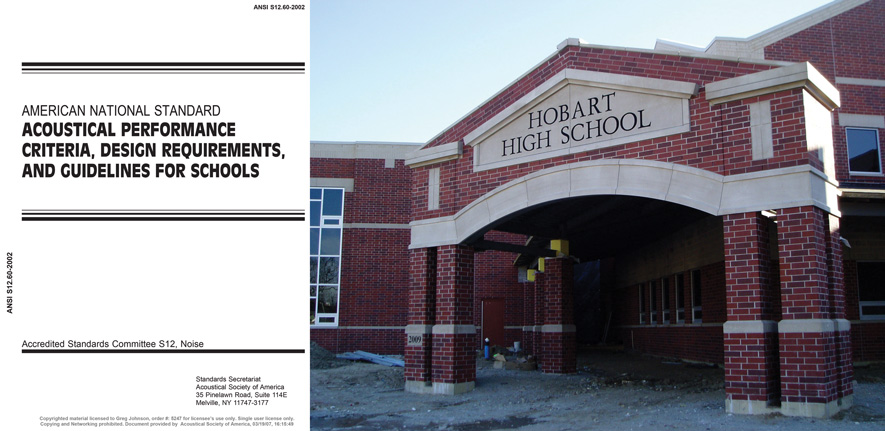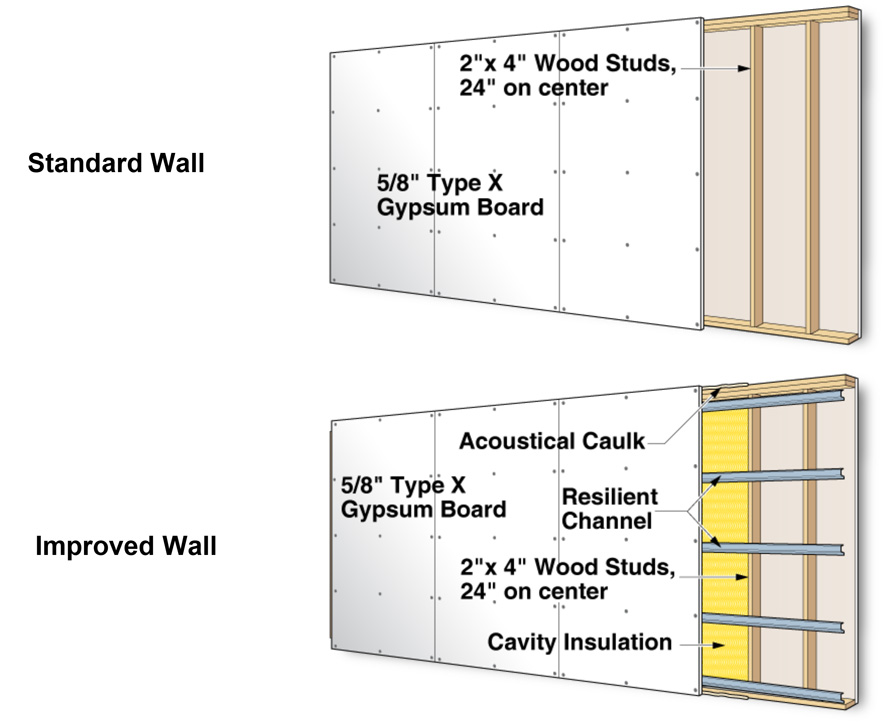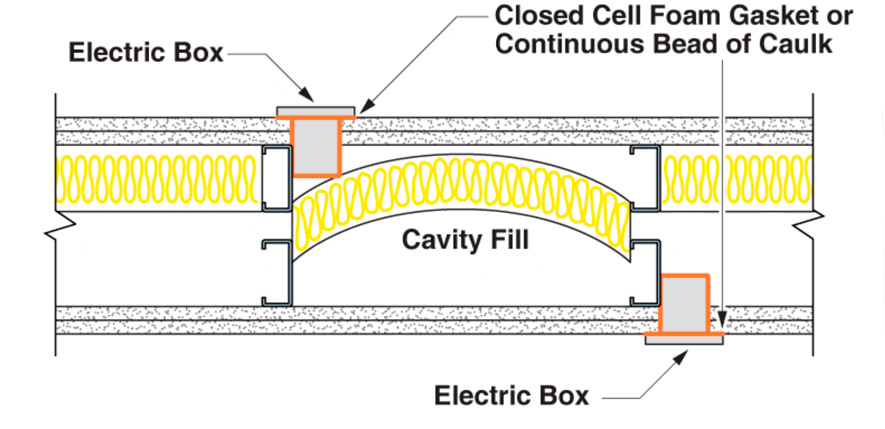Acoustical Control in Buildings
SOUND AND INDOOR ENVIRONMENTAL QUALITY
With an understanding of the principles of sound generation and sound transmission, we can focus on the impact of sound and noise on the indoor environment. We have all likely experienced situations where unwanted background noise has interfered with normal activities in a room or space. The response, if we are talking, is typically to speak louder. In fact, it is generally accepted that most people would need to speak at least 15 decibels (dBA) louder than the background noise level in order to be heard at all. This observation and others has led to the development of national standards, such as ANSI Standard S12.60: Acoustical Performance Criteria, Design Requirements and Guidelines for Schools, which establishes some very stringent thresholds for background noise. Specifically, for core learning spaces of 20,000 cubic feet or less, the one-hour steady-state background noise levels should not exceed 35 dB, while those more than 20,000 cubic feet should not exceed 40 dB. This is the same low level of sound that one would experience in a quiet office.

Images courtesy of CertainTeed Insulation
ANSI Standard S12.60 defines Acoustical Performance Criteria, Design Requirements, and Guidelines for Schools and is the basis for LEED for Schools acoustical prerequisites and credits.
ANSI S12.60 has also been recognized by the U.S. Green Building Council (USGBC) as a basis for performance in the LEED for Schools program with specific criteria in two cases. First, there is a mandated prerequisite for minimum acoustic performance in the Indoor Environmental Quality (EQ) portion of LEED. The stated intent of this prerequisite is, “To provide classrooms that are quiet so that teachers can speak to the class without straining their voices and students can effectively communicate with each other and the teacher.” The LEED prerequisite requirements follow the same ANSI thresholds for size and dBA levels of background noise, although it is only stated to address HVAC equipment noise.
There is also an additional IEQ credit for Enhanced Acoustic Performance with a stated intent, “To provide classrooms that facilitate better teacher-to-student and student-to-student communications through effective acoustical design.” In educational settings under ANSI Standard S12.60-2002, single or composite wall assemblies should provide STC ratings whenever separating a core learning space (e.g. a classroom) from other specific adjacent spaces as follows:
- STC-45 if the adjacent space is a corridor, staircase, office or conference room;
- STC-50 if the adjacent space is another core learning space, speech clinic, health-care room, or outdoors;
- STC-53 if the adjacent space is a restroom;
- And STC-60 if the adjacent space is a music room, mechanical equipment room, cafeteria, gymnasium, or indoor swimming pool.
- Classroom doors should be rated as STC-30 or more, and music room doors as STC-40 or more. Commonly, entry doors located across a corridor are staggered to minimize noise transmission from one room to another across the hallway.
It should be noted that open-plan classroom designs will not meet the requirements of this standard since there is nothing to impede the sound transmission from one space to another. In addition, STC ratings ranging from 45-60 are also outlined in the ANSI standard for assemblies separating non-classroom spaces from adjacent spaces.
Since classrooms can also be above or below each other, ANSI Standard S12.60 also identifies specific impact insulation class (IIC) ratings and recommendations for classroom learning spaces, including the following:
- IIC ratings for floor-ceiling assemblies above core learning spaces should be at least IIC-45 and preferably IIC-50 as measured on floors without carpeting.
- New construction, a gymnasium, dance studio, or other spaces with high floor impact activities shall not be located above core learning spaces.
- In existing facilities, IIC-65-70 (depending on the volume of the space below) is recommended if gymnasia, dance studios, or other spaces with high floor impact activities are located above core learning spaces.

Images courtesy of CertainTeed Insulation
An increasing number of codes, standards, and guidelines are addressing acoustical performance as a matter of public health, safety, and welfare.
Standards like this are becoming more common for other building types, too. Hospitals and health-care facilities are recognized in LEED v4 with criteria for sound control as part of the Indoor Environmental Quality portion. Additionally, the 2010 FGI Guidelines for Design and Construction of Healthcare Facilities, a recognized standard for minimum space, architectural detail, and surface and furnishing requirements in healthcare facilities, also address acoustics and speech privacy. They indicate that background sound generated by building systems and sound isolation need to be considered for occupied spaces in order to reduce noise produced annoyance. They reference the Sound and Vibration (SV) Design Guidelines for Hospitals and Healthcare facilities for compliance. Related to that, Health Insurance Portability and Accountability Act (HIPAA) regulations require speech privacy and room noise levels not to exceed specific compliance requirements.
When it comes to residential buildings of all types, there are a number of standards for privacy and sound control. This is true particularly in multifamily buildings, hotels, and other similar occupancies. The specific criteria look at STC and IIC ratings between adjacent spaces with predictably higher ratings needed between bedrooms and active areas. Suitable ratings for office and workplace spaces have been investigated and developed. The recommended STC ratings for a variety of adjacencies are published in Architectural Graphic Standards and promulgated by the North American Insulation Manufacturers Association (NAIMA) headquartered in Alexandria, Virginia.
Green Building Codes, such as the International Green Construction Code (IgCC) and the California Green Building Standard (CalGreen), similarly address acoustic control in all types of buildings. Many of these standards and requirements are responding to independent research conducted in a variety of university and clinical settings to determine the relative effects of noise on people in indoor environments. The findings have been convincing enough to determine that background noise can contribute to poorer performance in schools, longer patient recovery times in health-care settings, and detrimental health effects to employees in any setting. As a matter of public health, safety, and welfare, then, acoustics is increasingly being viewed as a significant component.
SOUND MITIGATION IN EXTERIOR AND INTERIOR WALLS
With an understanding of the principles and requirements of sound control, we can turn our attention to some ways to achieve the needed acoustic performance. Fundamentally, there are only three basic ways to attenuate or reduce sound. First, we can address the source by replacing the source sound with a quieter one when that is in our control, such as locating quieter rooms away from noisier ones. Second, we can address the listener’s location by blocking sound from entering the space with solid, heavy material that resists the transmission of airborne sound waves. Third, we can consider the path that sound travels from the source to the receiver and not only seek to resist transmission, but use lighter, porous materials that can absorb or soak up the sound waves. These three ways to control sound are the basis for the strategies discussed in the following paragraphs.
When looking at walls, it is all about the design and details of the wall assembly. Sound striking a surface of a wall causes that surface to vibrate, much like the diaphragm of a drum. The more massive the wall, the less the amplitude of vibration of the wall. This results in less noise being transmitted to the room on the other side of the wall. In cases of exterior walls in large commercial buildings where OITC is being addressed, this sheer mass approach may be a viable one. Since most new exterior walls are filled with insulation and fairly well-sealed for thermal performance, the good news is that those same measures should help notably with acoustical performance. If heat energy flow can be restricted in a wall then sound likely will be, too.

Images courtesy of CertainTeed Insulation
Multiple strategies exist to improve on the acoustical rating of a standard framed wall (STC 30) compared to one with acoustical insulation and resilient separation of gypsum board from the studs (STC 50).
For interior walls and partitions, it is rarely practical to rely on sheer mass to reduce the transmission of noise. Rather, lighter-weight framed walls are more common. In a conventional framed interior partition (e.g. ½-inch gypsum wallboard on either side of 2-by-4 wood studs on 16- or 24-inch centers) sound vibration is readily transmitted through the gypsum board, the studs, and the air space between the studs to the opposite side of the wall where it is heard as noise. In this case, the sound reducing property of the air space is negated by the studs, which form a direct structural connection between the two wall surfaces and allow the sound to pass through. Such a wall would likely test out with an STC rating of around 29. In practice, a wall system in an office setting with an STC 35 or less is considered low performance, whereas one with an STC 55 or higher is considered high performance.
In order to improve the amount of transmission loss and the corresponding increase in STC ratings in lightweight walls, several strategies are common. The use of light-gauge steel studs at 24 inches on center, instead of wood studs at 16 inches on center, can help increase the values in some scenarios since the thin steel stud may provide less of a connection between the two wall faces and allow less sound energy to be transmitted. One of the most cost effective and straight forward things to do is install 3½-inch-thick fiberglass acoustical insulation in the stud cavity of either wood or steel framed assemblies. Taking the effect of the insulation into account with ½-inch gypsum board on both sides, the performance improves in a wood framed wall to STC 39 and in a steel stud framed wall to STC 48. To improve the wood framed assembly, resilient channels can be used to isolate the materials and raise the STC rating. Such resilient channels, of which there are several types and designs available, can be installed across the face of the studs before the gypsum board is installed, thus eliminating direct mechanical connection of the gypsum wallboard to the studs. With the combination of insulation, ½-inch gypsum board on resilient channels (one side) spaced at 24 inches vertically, the STC rating of a wood framed wall can be increased to STC 48.
Adding additional layers of gypsum board on one or both sides is also effective since it provides some increased mass, which can reflect more sound and decrease the amplitude of vibration, thus reducing the transmitted noise level on the other side of the wall. Using two layers of ½-inch gypsum board on wood framed walls with insulation brings the STC rating up notably from 39 to 55 and up to STC 57 if resilient channels are used. In steel stud framed walls with two layers of ½-inch gypsum board and insulation, the performance increases from STC 49 up to STC 55. If 5⁄8-inch gypsum board were used in two layers on each side, instead of ½-inch, the performance can increase by an additional STC rating level of 2 to 4.

Image courtesy of CertainTeed Insulation
More creative strategies, such as double-stud separated framing coupled with insulation, double layers of gypsum board, and sealing around penetrations that are separated, can produce superior results in the range of STC 60 or better.
Alternatives to adding more gypsum board exist by framing the walls a bit more creatively. For example, while a typical 2-by-4 wall would commonly have a 2-by-4 top and sill plate, using 2-by-6 plates allows the studs to be staggered on the plates and isolate the gypsum board on each side at every other stud. This would raise the STC rating, with insulation, from STC 39 to STC 45, or to STC 48 if 5⁄8-inch gypsum board were used. If still higher performance is needed, then it is common to separate the staggered studs into a double-stud wall construction. In this case, two rows of studs are installed with a gap between the rows so none of the studs, top plates or sill plates touch each other. This breaks the mechanical connection between the two wall surfaces, completely interrupting the sound transmission. Then a double layer of fiberglass sound absorbing insulation can be installed in the wall cavity and be fully effective since it is no longer compromised by the studs. The STC rating of this type of assembly can range from STC 58 with one layer of ½-inch gypsum board on each side of wood studs up to STC 67 with two layers of 5⁄8-inch gypsum board on each side. Comparable performance can be achieved in steel stud framed walls.
When it comes to selecting the acoustical insulation to use in assemblies like these, it is incorrect to assume that higher-density insulation within the wall system provides better sound transmission loss. Comparative tests conducted at nationally recognized acoustical laboratories have shown that increasing the density of the insulation while maintaining a constant thickness does not have a significant effect on the STC rating of the construction. It is also incorrect to assume that heavy insulation in the stud cavities increases the STC because it adds weight to the wall. Actually, to increase the STC of a wall by adding weight, the weight must be added to the faces of the wall, not its core. For these reasons, mineral or rock wool insulation has not been shown to perform better than low-density fiberglass insulation when comparing identical thicknesses. These same tests show that insulation thickness within the wall cavity is the most important property, and that complete filling of the cavity between wall surfaces provides the best wall performance.
Beyond this isolation of surfaces, it is appropriate to consider all of the gaps and openings that can exist around framing and other wall materials. Avoiding direct pathways through penetrations of the wall is important, including things like electrical outlets and other things that are commonly run in stud-space cavities. Using an acoustical sealant will help fill the gaps around openings and at connections and prevent sound from being transmitted through these wall penetrations. Acoustic sealants commonly include silicone, latex, or acrylic-based formulations acoustically engineered to block sound with non-drying and non-hardening characteristics that allow it to retain its acoustic properties over time. Acoustic sealant is available for interior and exterior applications on a variety of different surfaces, including gaps between wall stud plates and subfloor, openings around electrical outlets and boxes, air ducts and boots, doors, windows, and other wall and floor penetrations or gaps. Sealant can contribute to a reduction in perceived noise levels through the walls on the order of 2 to 3 dB, which is enough to be noticeable.









